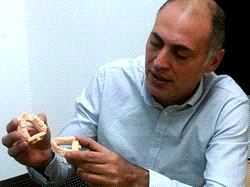Inkjet & Digital Printing
Some Straight Talk (and a Round Award) for 3D Printing in Orthodontics

Tuesday 04. March 2014 - 3D printing is becoming increasingly popular with dentists, but an even greater percentage of orthodontists are prepared to make the leap to digitizing their "shops" - or they already have! The compact Objet30 OrthoDesk, award-winning digital dental workhorse Objet Eden260V and the just launched Objet Eden260V DentalAdvantage 3D Printers by Stratasys are equally useful and productive for orthodontic labs and practices.
So it’s no wonder that the Objet Eden260V has just won The Dental Advisor magazine’s 2014 Product Award for rapid prototyping, for the second straight year. The magazine highlighted the Objet Eden260V’s outstanding surface detail, easy management and maintenance, high resolution in all axes, and high speed in high quality 3D printing modes as reasons for its selection.
How can the switch to digital orthodontics make a difference for both orthodontists and patients?
When a practice has “gone digital,” the 3D experience begins right away. The first part of any orthodontic treatment is casting the “before” mold of the teeth, with all the faults that require correction. More and more orthodontists are turning away from the traditional dental impressions in silicone, sodium alginate or polyether. Instead, they’re using intra-oral scanners to get a full view of the anatomy of the mouth, jaws and teeth. These 3D scans are then “print ready” – 3D printers take that digital information and produce an exceptionally accurate 3D printed model.
Stratasys’ Director of Global Dental, Avi Cohen, explained how 3D scanning and 3D printing can benefit orthodontists: “It is standard practice for orthodontists to keep the original (or ‘before’) impressions for each patient for several years – five to nine, depending on location. For orthodontic practices of any size, this can create a huge storage problem since all those physical models need a home! But with digital files, they are stored electronically and models can be 3D printed on demand if necessary.
“Another outgrowth of 3D printing in orthodontists’ offices is the 3D printed guide. Acting as a “road map” for placing brackets or other parts of the treatment, busy practices can rely on dental assistants to treat patients using these individual treatment guides.”
“Unlike the braces of decades ago, a popular choice for adults to correct their teeth alignment are ‘invisible braces,’ a series of transparent corrective appliances that are worn for short periods of time. These ‘aligners’ move the teeth from their original position but without any disruption to the patient’s appearance – a clear advantage for individuals who are already in the professional world or older than the typical orthodontic patient. Orthodontic labs such as ClearCorrect can quickly 3D print the models of the teeth on one of their fleet of Objet Eden500V 3D Printers; these models are then shipped to their customers (orthodontists) with the series of aligners tailored to each patient. They can also take advantage of our new VeroGlaze (MED620) material which provides excellent color-matching for dental molds and models.”
Although 3D printing and other 3D technologies are helping to solve problems unique to the orthodontics industry, other solutions are shared across many kinds of manufacturing. 3D printing is answering the call to offer case-by-case, individualized models in a fast and cost-effective way. Are you ready to sink your teeth into “next generation” orthodontics?
